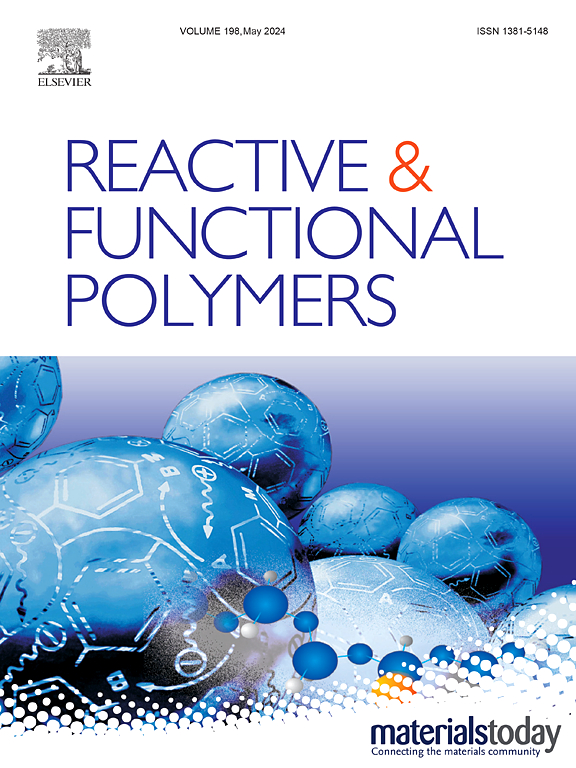Hot-melt polyurethane adhesive using dynamic reversible phenol−carbamate bonds
IF 5.1
3区 工程技术
Q1 CHEMISTRY, APPLIED
引用次数: 0
Abstract
Adhesives are essential in several applications, including transportation, construction, electronics, aircraft, and human organs. However, due to their cross-linked chemical structure, industrial polyurethane hot melt adhesives utilized worldwide are non-recyclable. Here, we developed a facile route to polyurethane hot-melt adhesive (PU-HMA) synthesis by incorporating a phenol-carbamate bond into a three-dimensional dynamically cross-linked polyurethane system, which is notably reworkable. Reversible covalent phenol-carbamate bonds have led to the development of a new class of PU-HMAs. This system combines the advantages of reworkable thermoplastic polyurethane hot-melt adhesives and highly reactive polyurethane hot-melt adhesives, enabling efficient bonding and debonding on demand. Such a structure creates a highly cross-linked covalent network, resulting in reversible adhesive properties that enhance the overall performance of hot-melt adhesives. Two types of PU-HMAs with different crosslinking densities were prepared. As a result, the adhesive exhibited an impressive initial and ultimate adhesion strength for PU-HMA-1 (8.8 ± 1.09 MPa) and PU-HMA-2 (5.45 ± 0.39 MPa), respectively. This adhesive exhibited superior solvent resistance and commendable endurance. In PU-HMA-1, it retained at least 23 % of its initial lap shear strength; in PU-HMA-2, it retained at least 38 %. Remarkably, the advantageous repeated adhesive capability was maintained even after being completely broken three times. After three cycles, PU-HMA-1 experienced a decrease in lap shear strength of only 1 %, while PU-HMA-2, with its high cross-linking density, experienced a significant decrease of 38 %.

热熔聚氨酯胶采用动态可逆苯酚-氨基甲酸酯键
粘合剂在许多应用中都是必不可少的,包括运输、建筑、电子、飞机和人体器官。然而,由于其交联的化学结构,世界范围内使用的工业聚氨酯热熔胶是不可回收的。在这里,我们开发了一种简单的聚氨酯热熔胶(PU-HMA)合成路线,通过将苯酚-氨基甲酸酯键结合到三维动态交联聚氨酯体系中,该体系具有明显的可重复性。可逆共价苯酚-氨基甲酸酯键导致了一类新的pu - hma的发展。该系统结合了可重复使用的热塑性聚氨酯热熔胶和高活性聚氨酯热熔胶的优点,能够根据需要进行高效的粘合和脱粘。这样的结构创造了一个高度交联的共价网络,从而产生可逆的粘合剂性能,增强了热熔胶的整体性能。制备了两种不同交联密度的PU-HMAs。结果表明,该胶粘剂对PU-HMA-1和PU-HMA-2的初始和最终粘接强度分别为8.8±1.09 MPa和5.45±0.39 MPa。该胶粘剂具有优异的耐溶剂性和耐久性。在PU-HMA-1中,它保留了至少23%的初始搭接抗剪强度;在PU-HMA-2中,它至少保留了38%。值得注意的是,即使在完全断裂三次后,仍保持了优越的重复粘接能力。3次循环后,PU-HMA-1的搭接抗剪强度仅下降1%,而交联密度高的PU-HMA-2的搭接抗剪强度显著下降38%。
本文章由计算机程序翻译,如有差异,请以英文原文为准。
求助全文
约1分钟内获得全文
求助全文
来源期刊

Reactive & Functional Polymers
工程技术-高分子科学
CiteScore
8.90
自引率
5.90%
发文量
259
审稿时长
27 days
期刊介绍:
Reactive & Functional Polymers provides a forum to disseminate original ideas, concepts and developments in the science and technology of polymers with functional groups, which impart specific chemical reactivity or physical, chemical, structural, biological, and pharmacological functionality. The scope covers organic polymers, acting for instance as reagents, catalysts, templates, ion-exchangers, selective sorbents, chelating or antimicrobial agents, drug carriers, sensors, membranes, and hydrogels. This also includes reactive cross-linkable prepolymers and high-performance thermosetting polymers, natural or degradable polymers, conducting polymers, and porous polymers.
Original research articles must contain thorough molecular and material characterization data on synthesis of the above polymers in combination with their applications. Applications include but are not limited to catalysis, water or effluent treatment, separations and recovery, electronics and information storage, energy conversion, encapsulation, or adhesion.
 求助内容:
求助内容: 应助结果提醒方式:
应助结果提醒方式:


